Is this plant causing your allergies? If you’ve ever blamed goldenrod, it might actually be ragweed — and they look nothing alike once you know what to look for. Here’s how to tell the difference with real photos and simple identification tips.
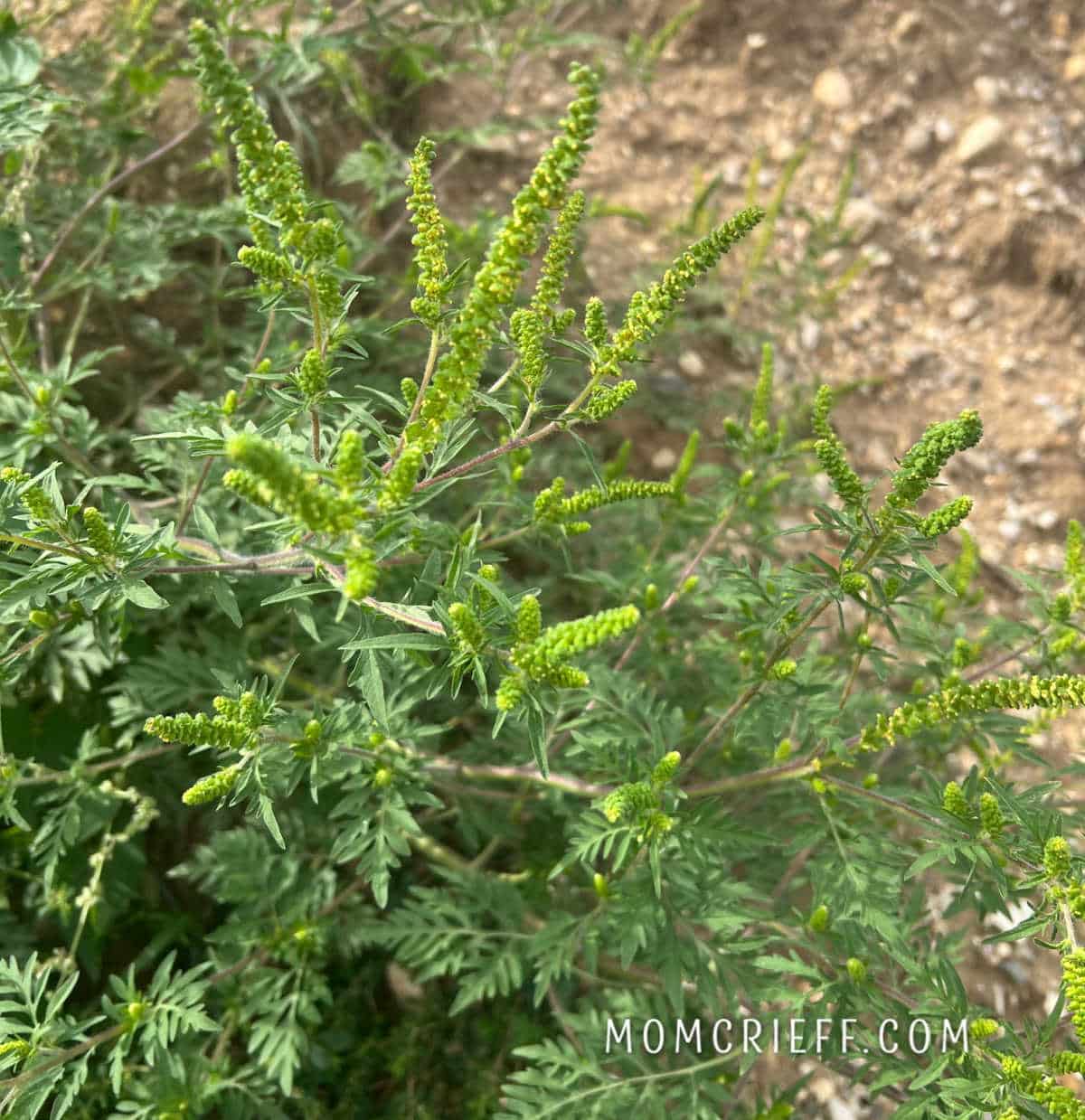
This plant is a good reason to keep your weeding in your garden under control! I've seen common ragweed happily growing in gardens (it's been in mine, too)! If you want a chemical-free way to control weeds, try this Cardboard Weed Barrier method! It works!
Table of contents
How to recognize ragweed
Ragweed is a very nondescript plant. Initially, when I tried to find out what it looked like, I asked at my local plant nursery and even a landscaper. No one knew. My research began. Once I knew what ragweed looked like, I saw it everywhere!
The above is common ragweed, and it does grow everywhere. I see it in the cracks of sidewalks, and it even is one of the first plants to grow in abandoned parking lots.
Ragweed Identification Checklist:
- Green, spiky flowers (not yellow)
- Fern-like leaves (deeply lobed)
- Grows in disturbed soil, roadsides, cracks, construction areas
- Blooms late summer through fall
- Often confused with goldenrod, which has bright yellow flowers
Watch this Ragweed Video
Below is a close-up image of a leaf. They are very distinct and look similar to a fern-type leaf.
Different types of Ragweed near Me (zone 5)
Common Ragweed
Common ragweed (Ambrosia artemisiifolia) does not have yellow flowers like the goldenrod plant does. Unfortunately, goldenrod blooms at the same time, and that's why it gets blamed for the hay fever and allergy symptoms caused by pollen allergies to ragweed. Ragweed flowers are very nondescript and are actually green, spiky-looking flowers.
Many people have a ragweed allergy; ragweed pollen is everywhere in the fall. I have found many people don't know what common ragweed looks like, and I've even seen it growing in people's yards. The first few ragweed images I'm sharing are the ambrosia artemisiifolia which is the common ragweed.
Pictures of common ragweed.
The spikey parts of the plant below are the flowers. It is green, and the pollen is yellow. Each plant can potentially produce a billion pollen grains.

Common ragweed (Ambrosia artemisiifolia) grows in most of the U.S. and Canada. It thrives in neglected spaces — like cracks in sidewalks, parking lots, gardens, and areas with disturbed soil.
Its green, spiky flowers often go unnoticed, but each plant can release over a billion pollen grains. If you suffer from allergies in August or September, this plant is likely to blame.
Take a close look at what the leaves look like. Between the flower and the leaves, that is how to tell what this plant is easily.
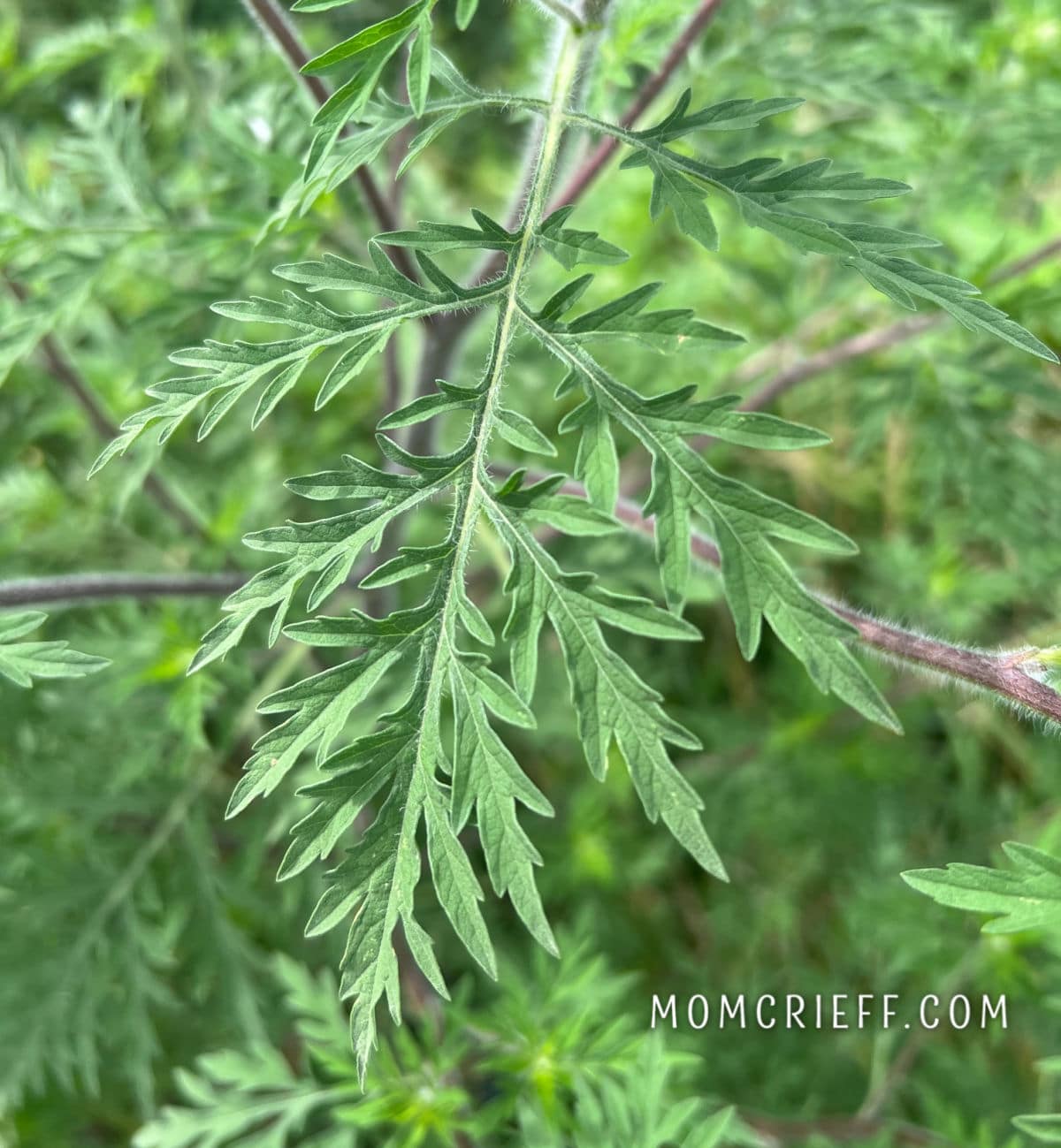
Giant Ragweed
This is giant ragweed (Ambrosia tridida). Once I saw it, I immediately recognized how similar the ragweed flower is. That green spikey thing is also the flower for this plant. And this is as pretty as this flower gets!
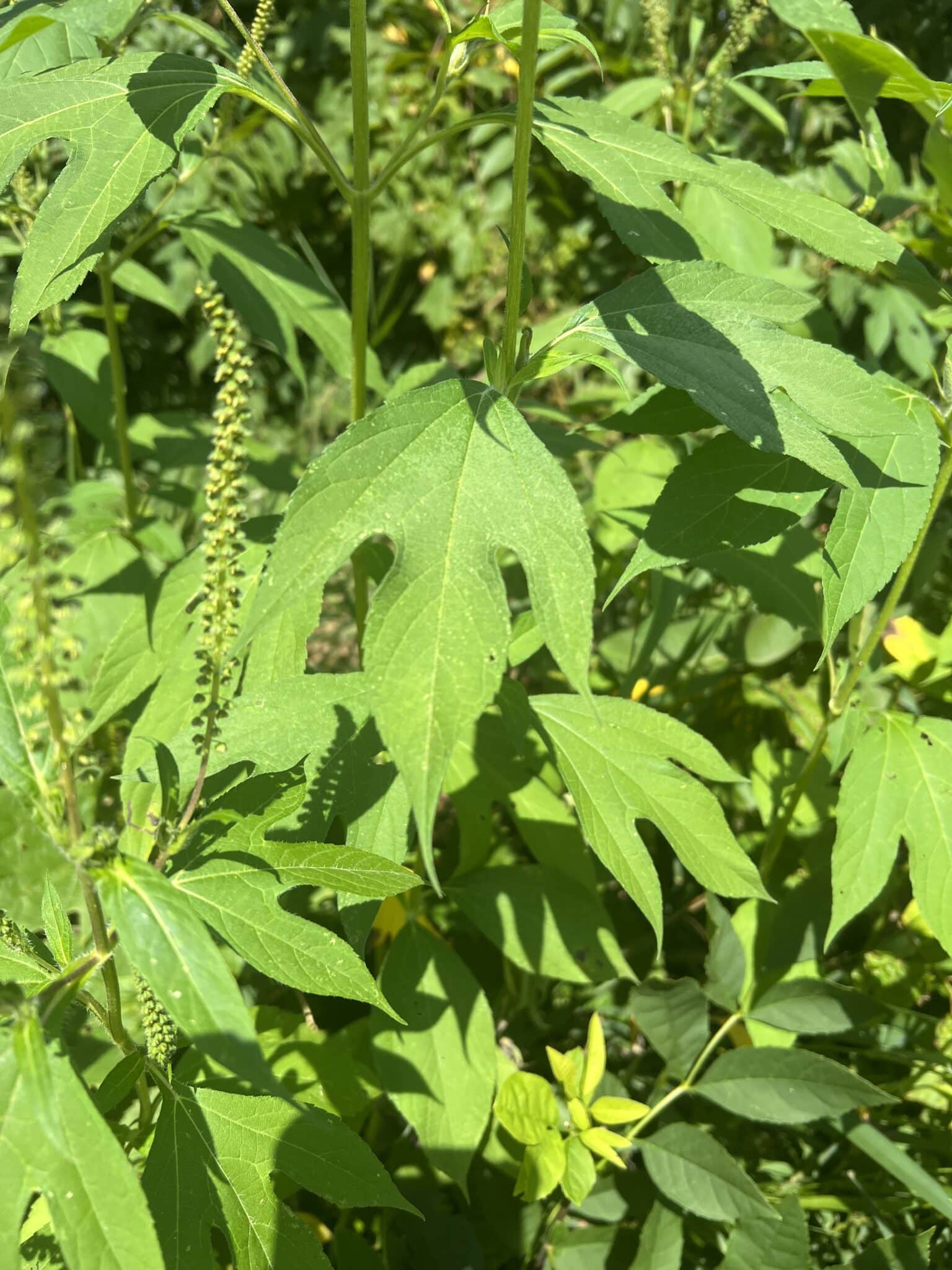
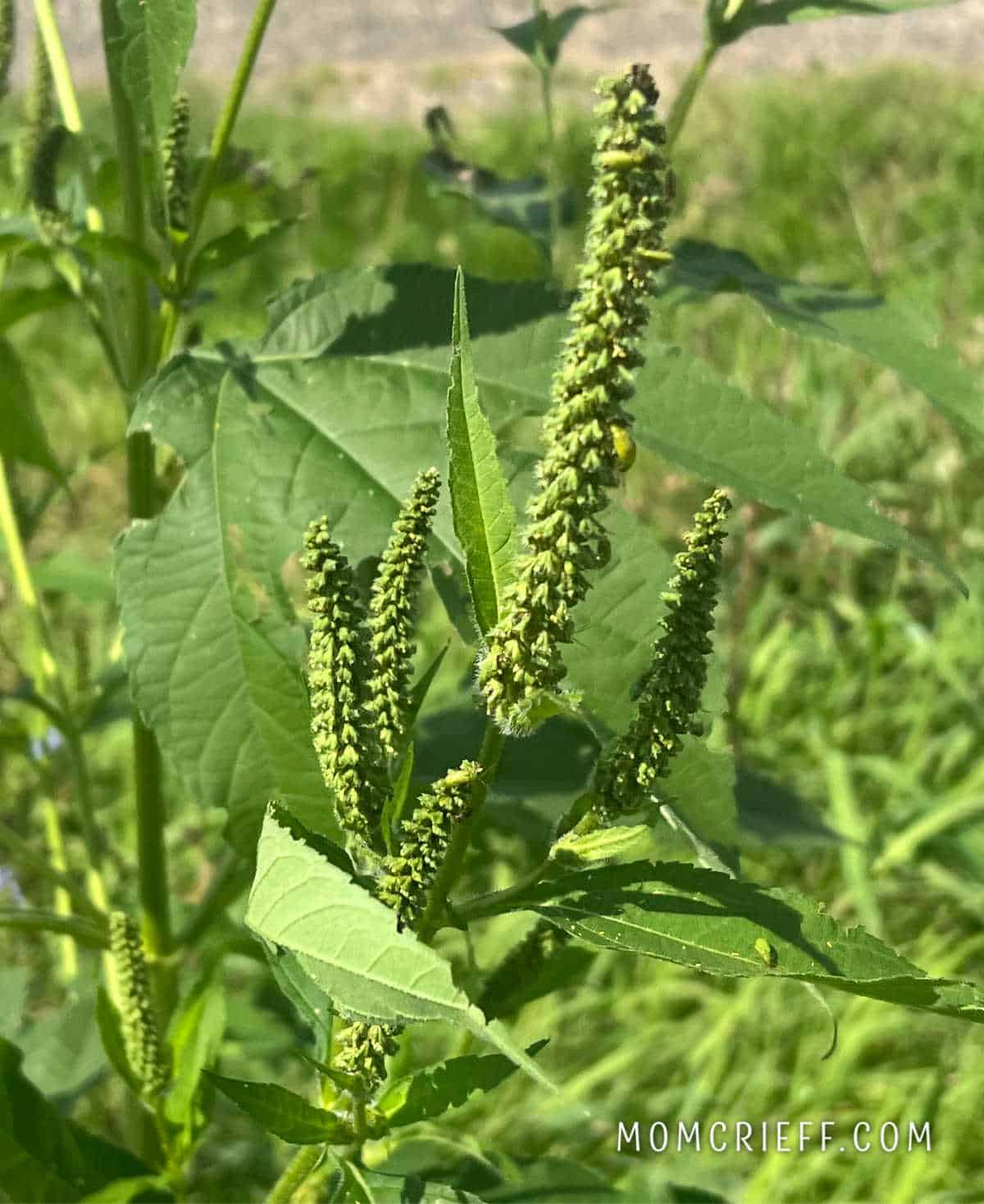
Below, do you see how they grow at the side of the road? So many people are allergic and often walk just a few feet away from a large plant!
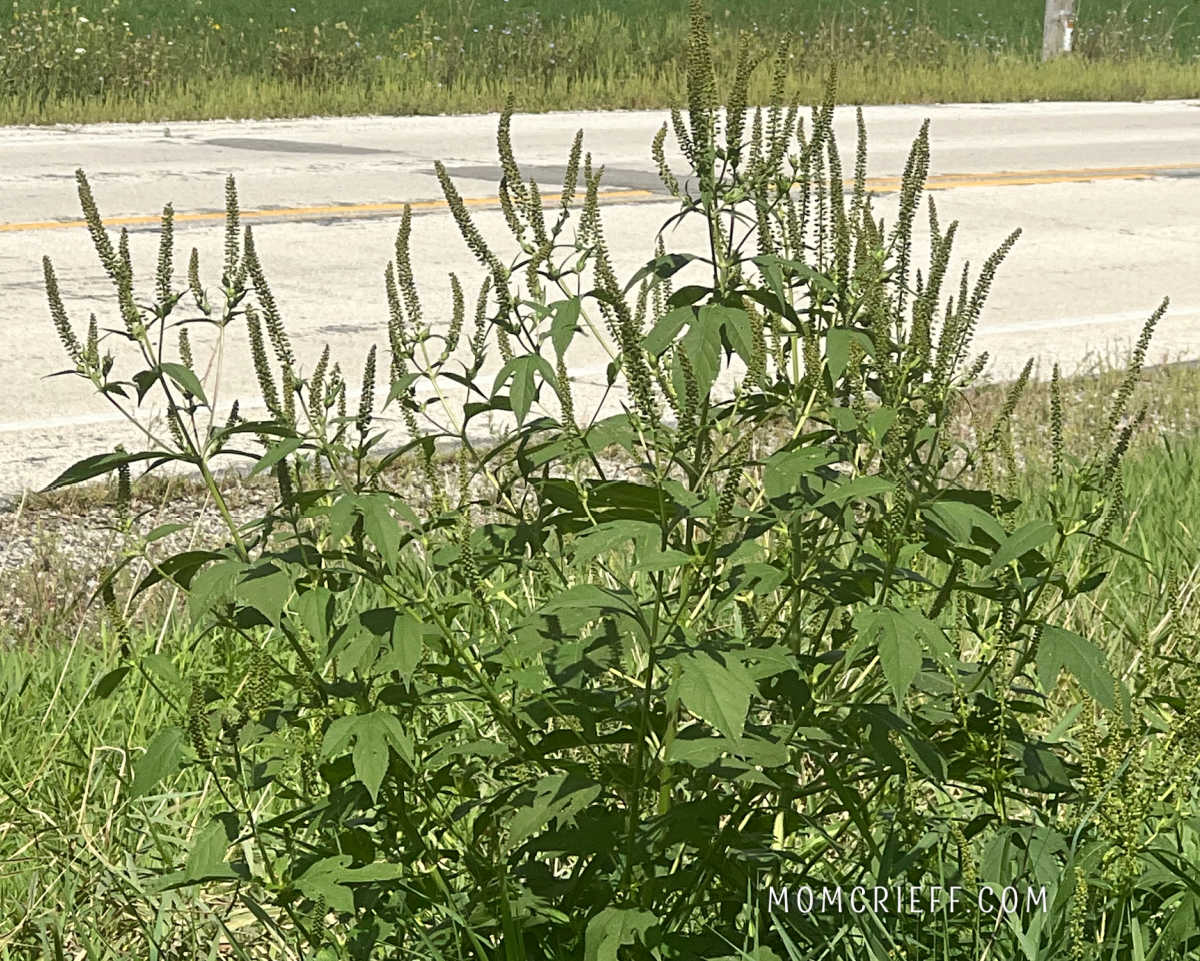
The picture below is a closeup of that giant ragweed leaf. Look at the very distinct shape. I've circled one so you can get a good look at it.
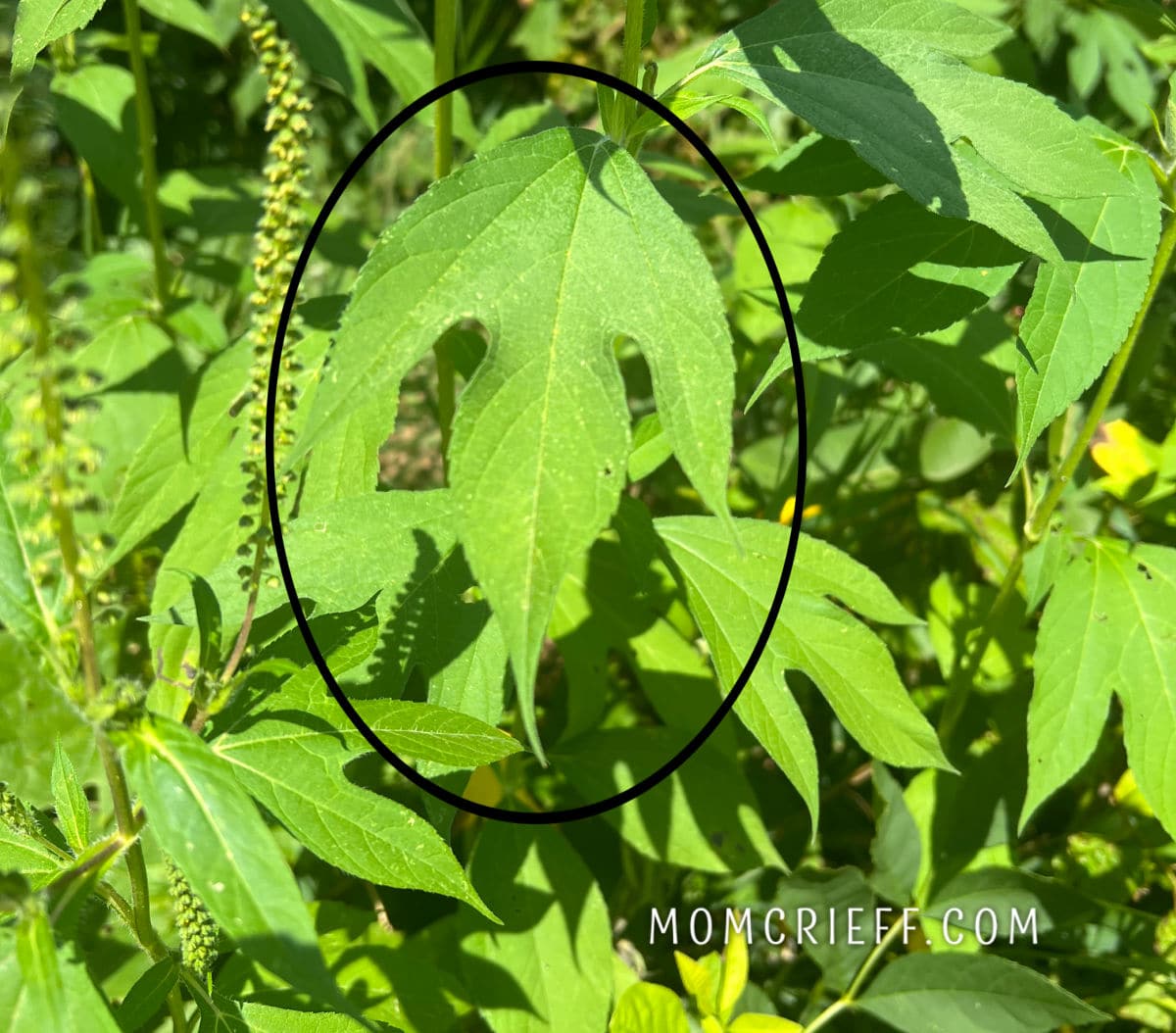
It should be noted that not all leaves have that shape. In this top-down picture, you can see that some of the smaller leaves, especially around the flower, don't have that defining shape.
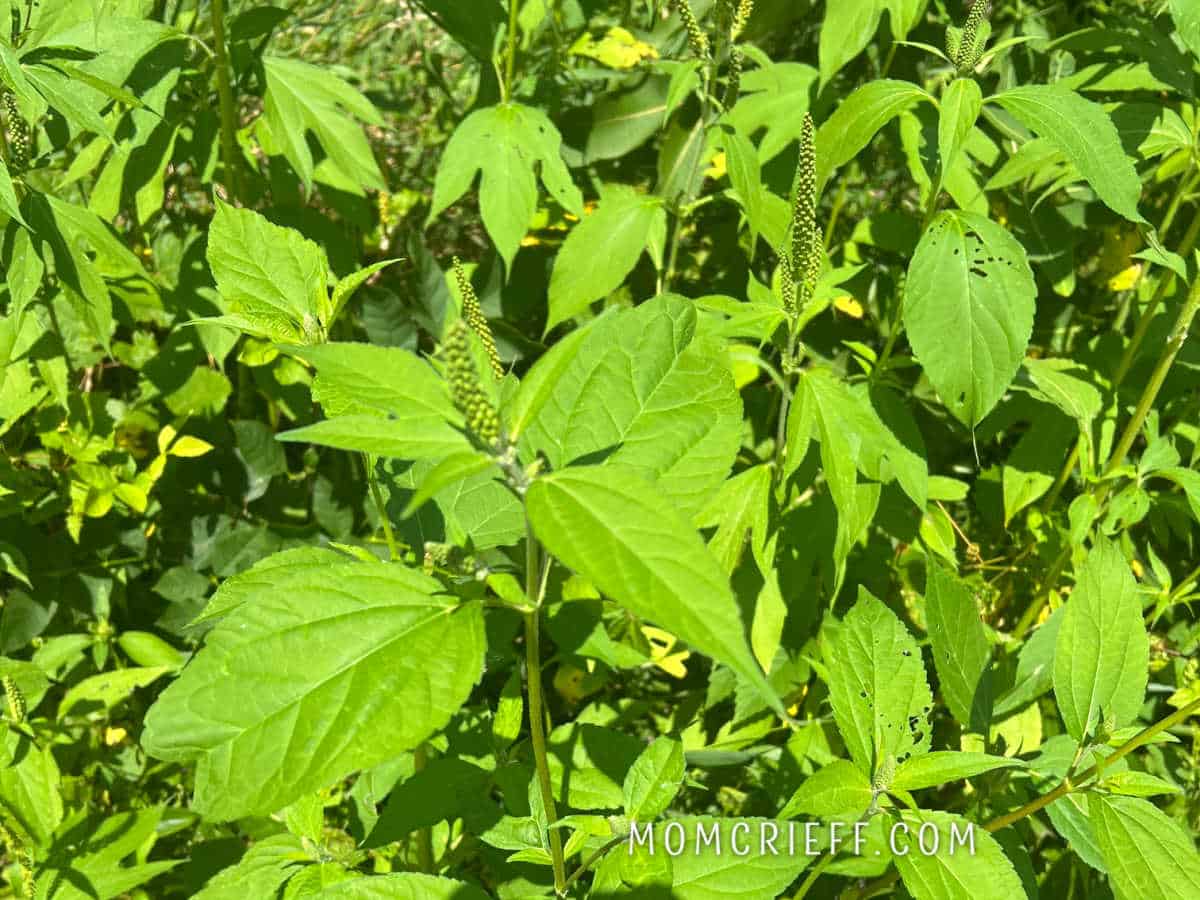
Goldenrod vs Ragweed
Goldenrod is the plant that gets mistaken for ragweed because it flowers at the same time. Many people overlook ragweed, but they see goldenrod when their allergies flare.
What Goldenrod looks like (side by side image)
A side-by-side image showing goldenrod blooming and ragweed blooming explains it best. Goldenrod is to the left, and ragweed is to the right. Poor goldenrod gets mistaken for ragweed because it flowers at the same time. The flower of the goldenrod is much more visible because it is a pretty and bright yellow.
What does goldenrod look like?
Here is a closer picture. Goldenrod blooms in the fall and has pretty yellow flowers. Compare that to ragweed with the nondescript green flowers and yellow pollen.
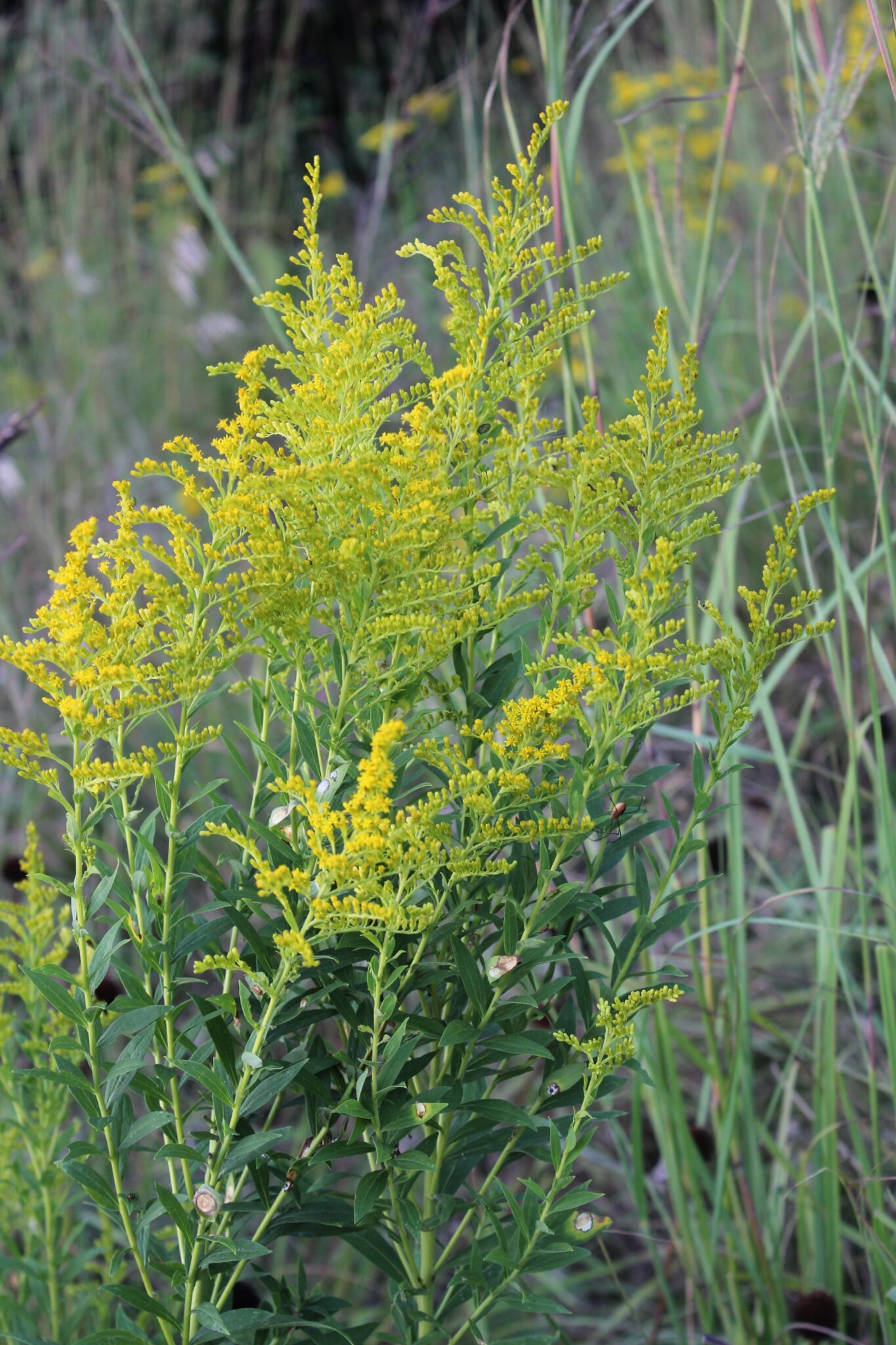
Goldenrod is the plant that gets blamed for the runny nose, scratchy throat, and congestion caused during the ragweed pollen season. Our bodies (our immune system) react to the allergens from ragweed by producing and sending histamine through our bloodstream.

There are different types of goldenrod. Above is a picture of the goldenrod that grows around me. The one pictured below was grown from seed in a naturalized field near me. It doesn't naturally grow in my area but still has a very yellow flower that blooms at the same time as ragweed.
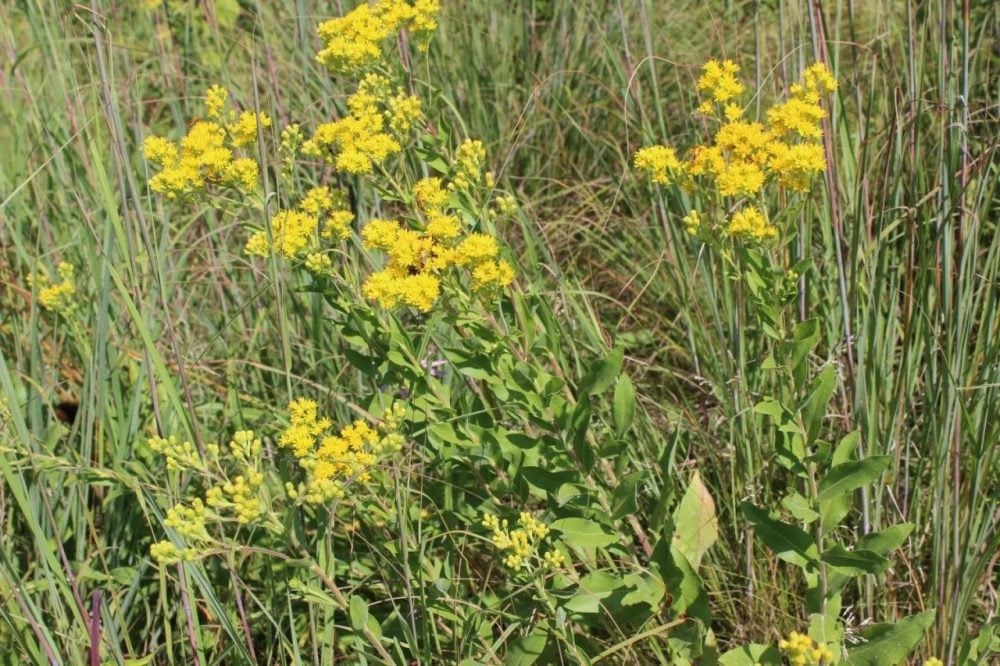
Where does ragweed grow?
It does grow in most areas of the United States and Canada.
Specifically, I looked for areas with recently disturbed soil when I was looking to update my ragweed pictures. I headed toward a local retail construction site, and finding some great specimens only took a few minutes.
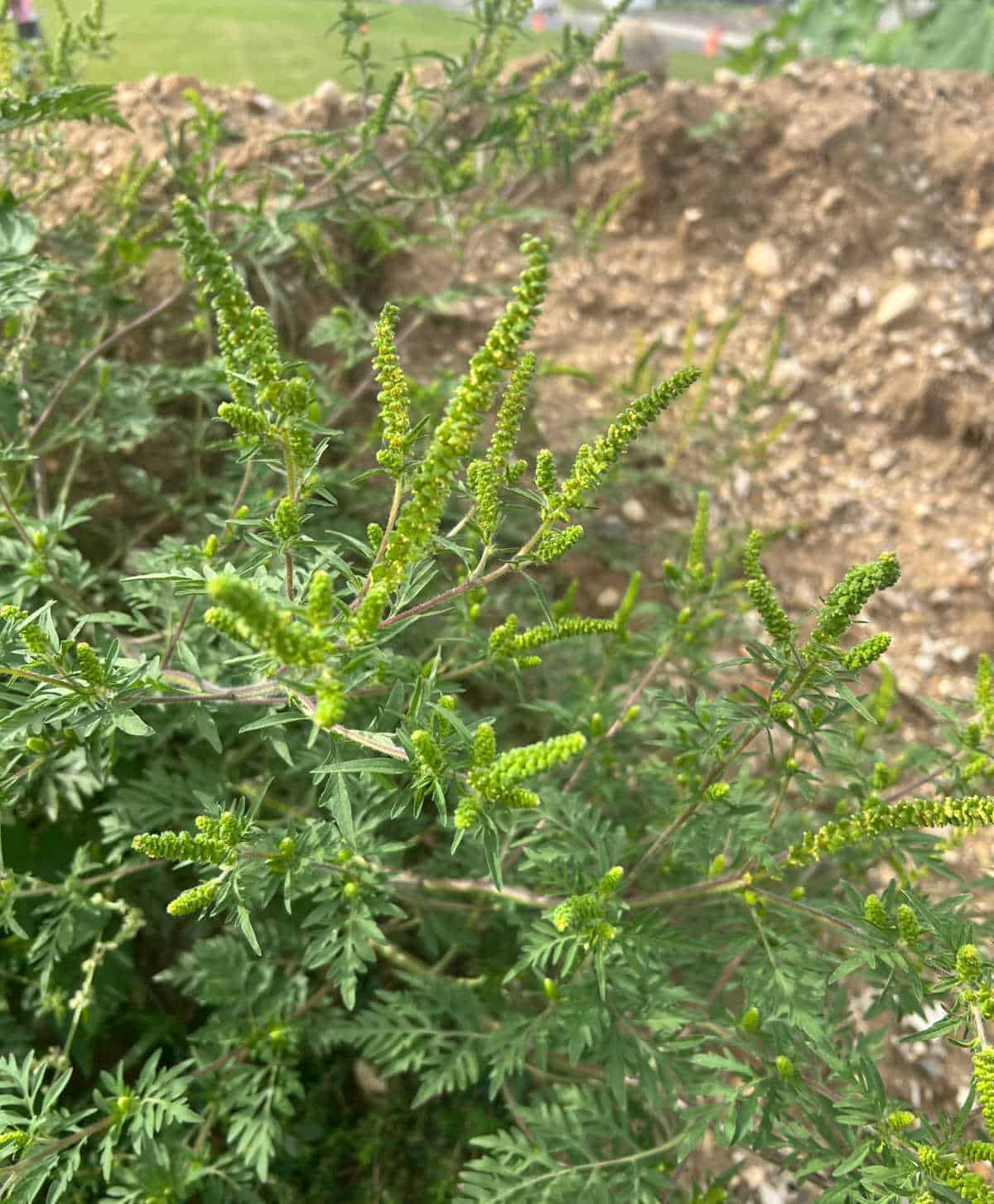
The above was just a mound of dirt near a construction site, and there were plenty of ragweed plants!
The image below is a young ragweed that doesn't yet have large flower spikes. I included the image so you can get a good look at the leaves of the plant. This plant really grows in what would be inhospitable to many plants.
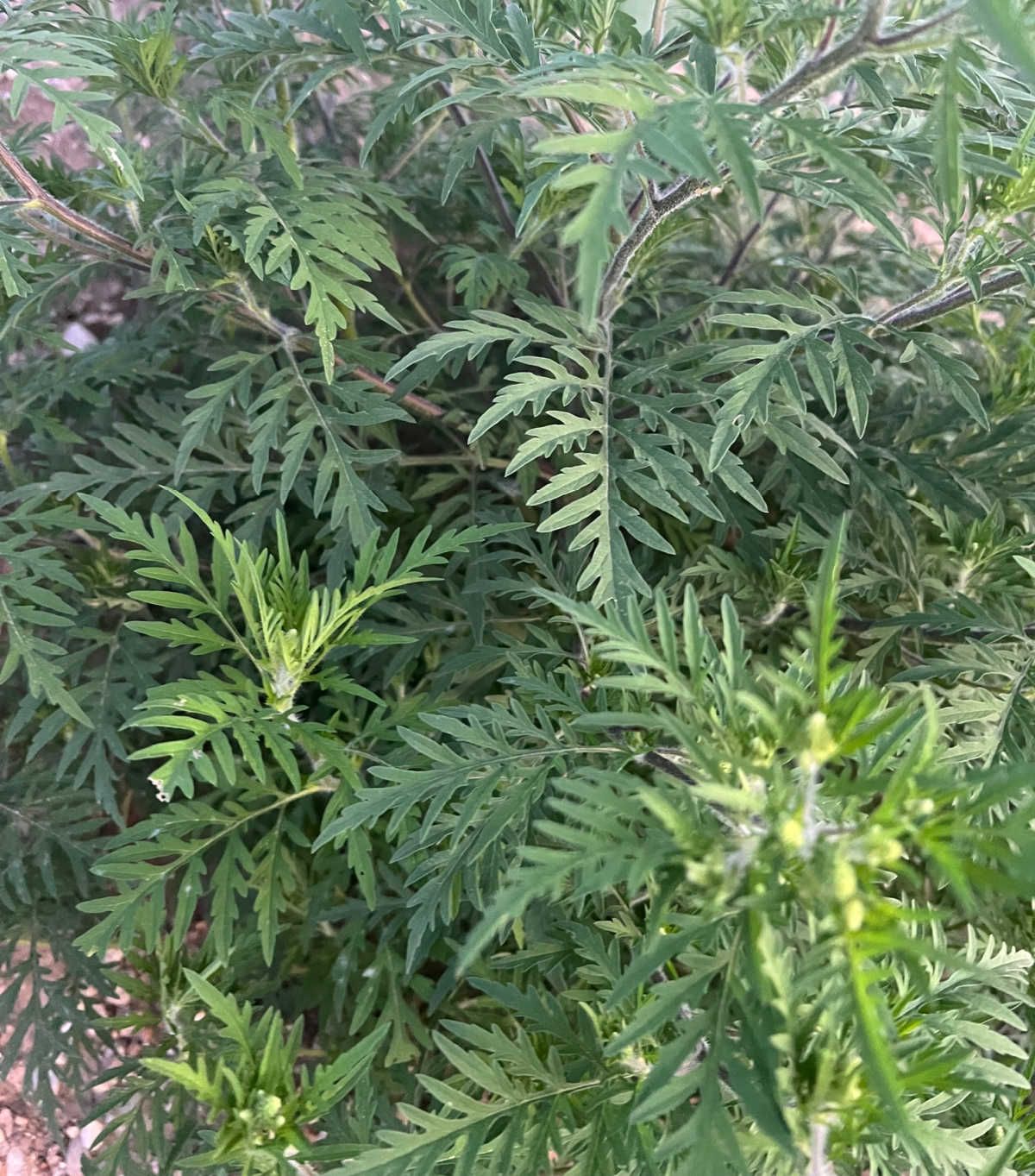
The picture of the ragweed below is in an abandoned parking lot of a closed-box store. Amazingly, they pop up and thrive in pavement and even concrete cracks. Part of the reason so many people suffer from a ragweed pollen allergy is the fact that this weed grows easily, even in urban areas.
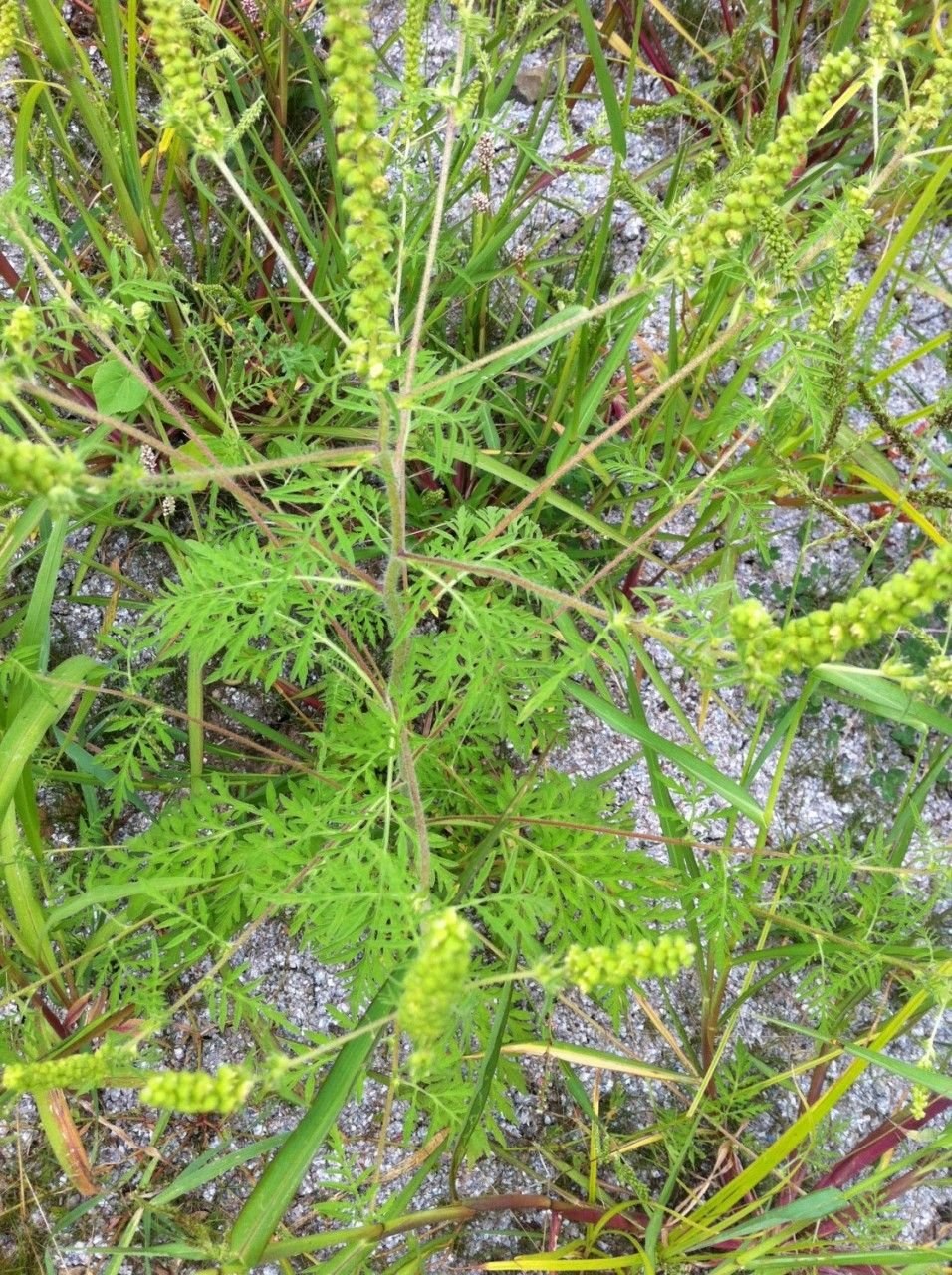
I was researching ragweed and thought it interesting that there are male and female flowers. Honestly, taking pictures is as close as I want to get to this plant. Like many people, I suffer from allergies and must start antihistamines early in the season.
Quick summary of how to tell the plants apart
Common Ragweed leaves are below.

Below are the giant ragweed leaves. They are quite different.

What color is ragweed pollen?
I have received quite a few people asking. The ragweed flower is green. The pollen is yellow.
A quick reminder! The goldenrod flower is yellow/golden and not green. It is NOT ragweed. The pictures below will help you identify goldenrod. Look at those leaves, too.
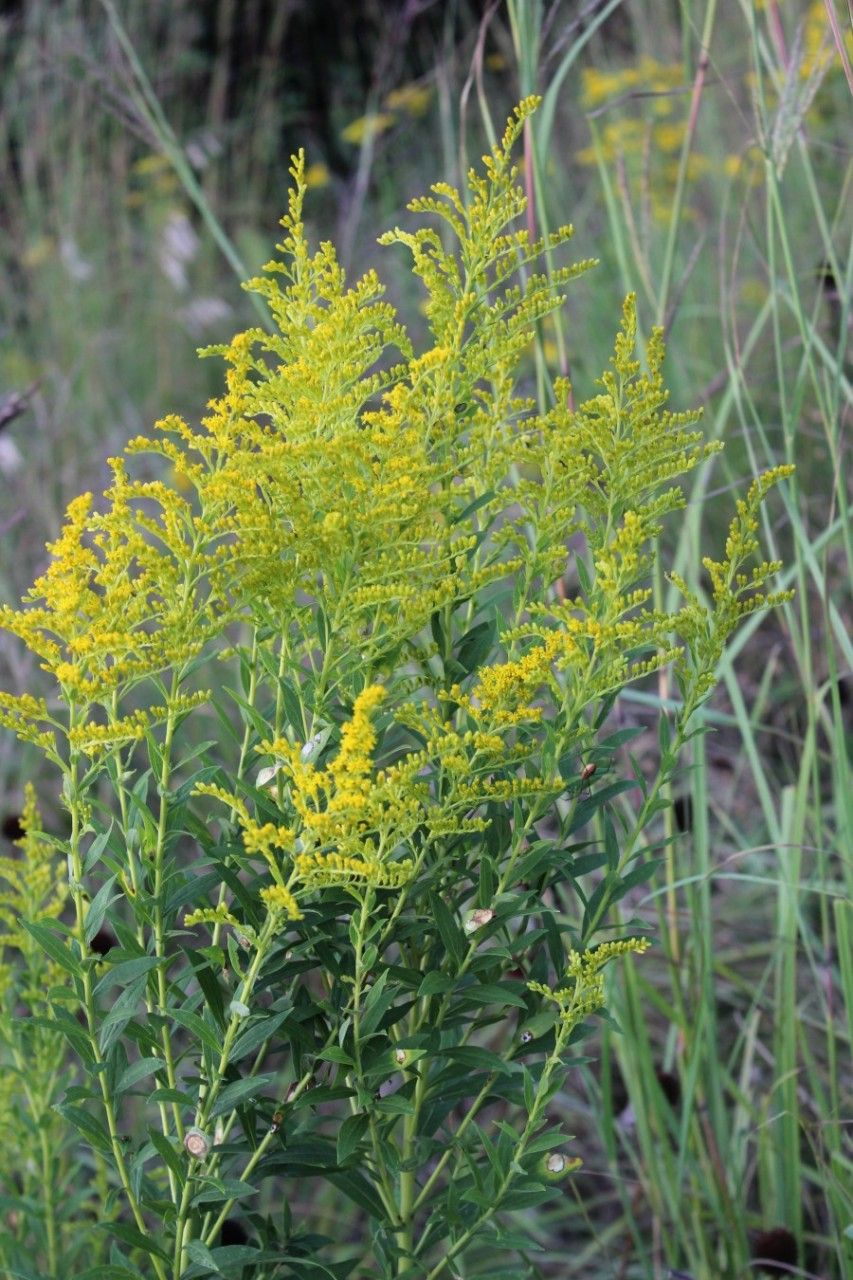
Hopefully, I've shown you the differences between goldenrod and two types of ragweed! Remember that both plants have different varieties, but my pictures should be a good guide. Remember, look at the leaves. That should be your best indication that the plant is ragweed and which kind of ragweed. And remember, the flower of ragweed is that boring green spike, not a pretty yellow!
FAQs
It generally starts in late summer in August and often ends in October. It all depends on the weather!
Prevention is the best method to control ragweed in your yard. If you see it, pull it before it flowers and spreads its pollen.
Symptoms include runny nose, itchy, watery eyes, headaches, sinus congestion, and sneezing.
**Below are some of the original ragweed pictures and commentary from when I originally wrote this post in 2014. I have found some folks like me to keep the original pictures and information during updates.
The first two pictures are of ragweed growing in really bright, sunny conditions (on the side of the road, between the road and the sidewalk.
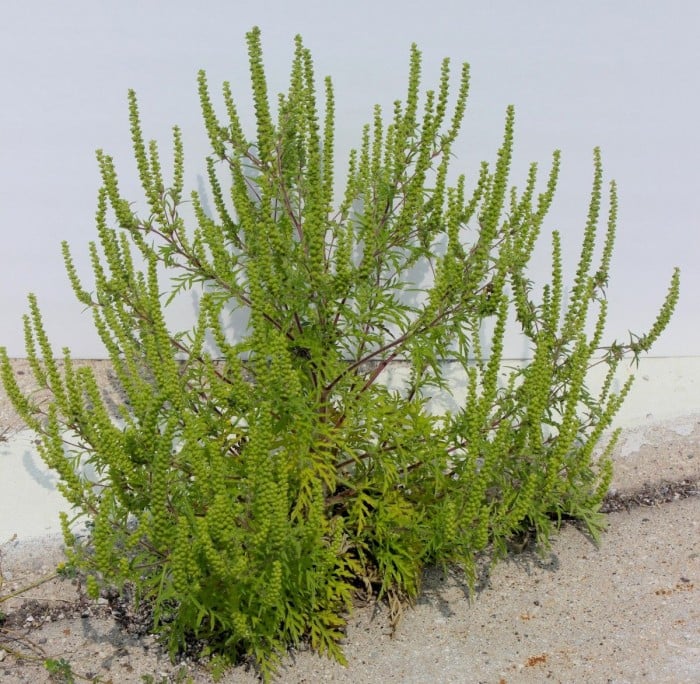

The next picture is a ragweed plant that I found in shadier conditions.
I hope these pictures of ragweed help you identify this weed that everyone is allergic to. Let's stop blaming the poor goldenrod plant for our allergy ailments!
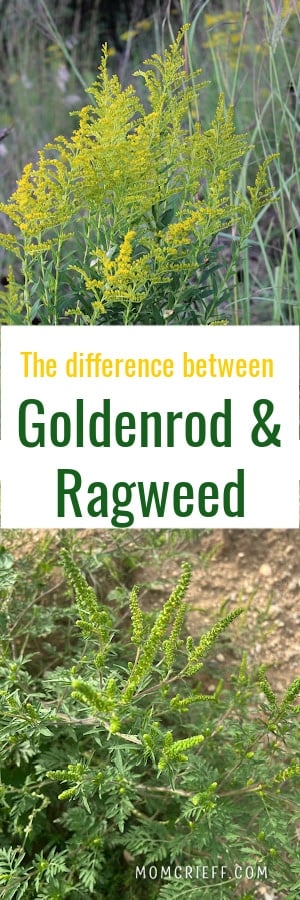
Be aware of the types of ragweed that grow around you. Along with common ragweed, there are also giant ragweed and western ragweed in large parts of the country.
Originally published October 2014.




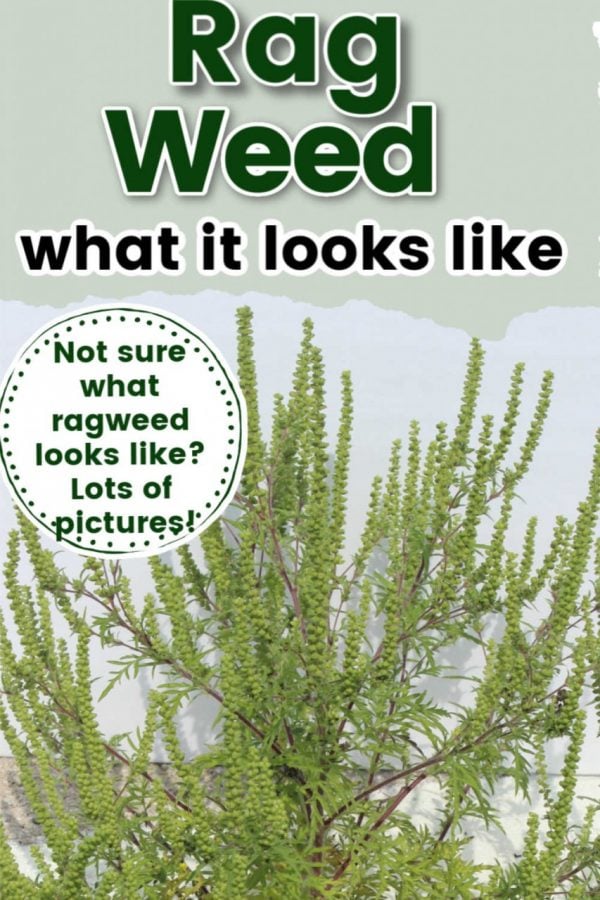
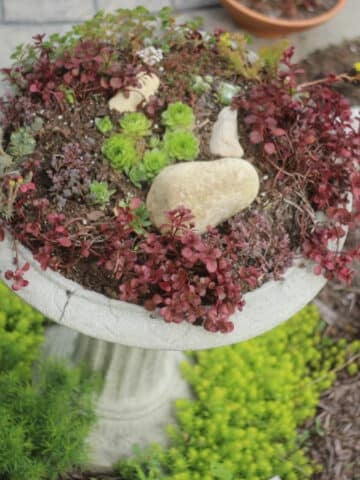
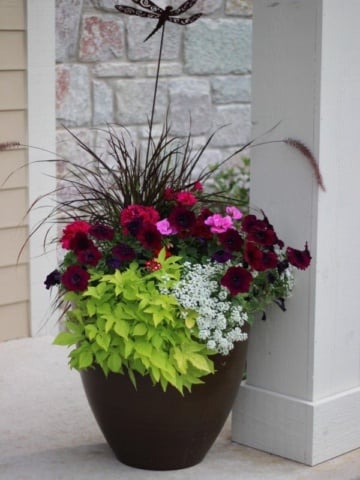
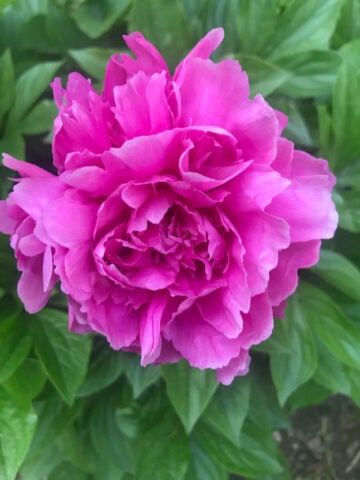
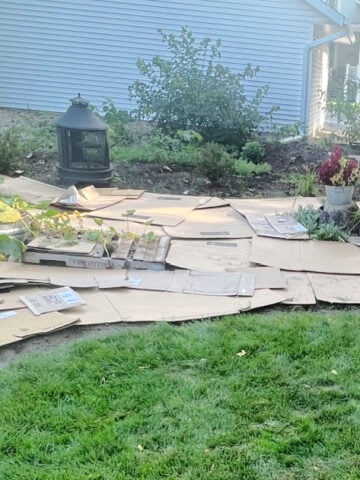
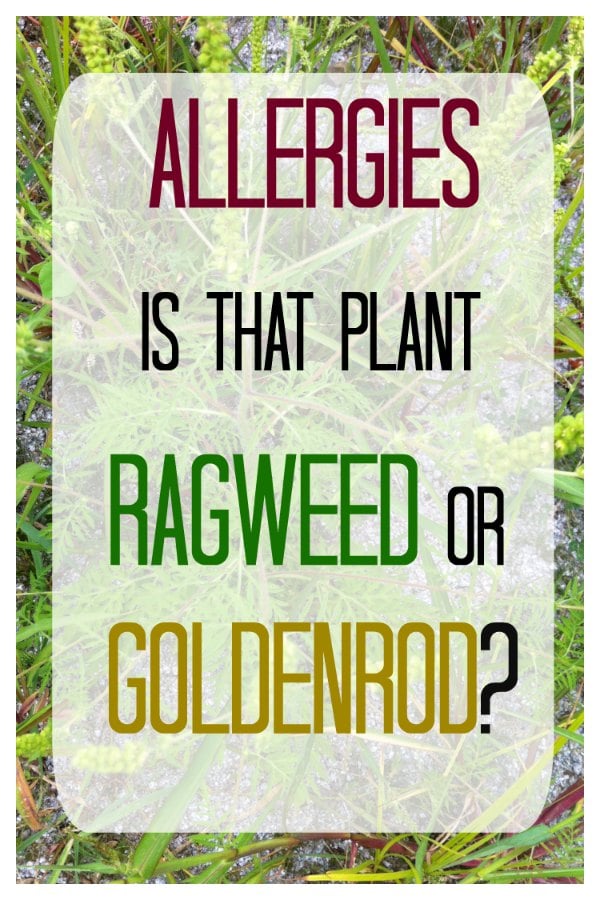
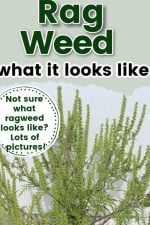
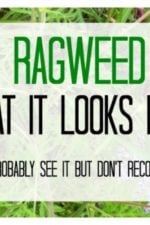
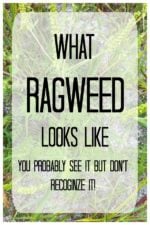
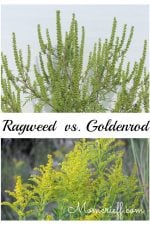
Rosetta
Hi! I could have sworn I've visited this website before but after going through some
of the posts I realized it's new to me. Nonetheless, I'm definitely pleased I discovered it and I'll be bookmarking
it and checking back frequently!
Shirley
Goldenrod is an allergy medicine. Funny how both these plants grow side by side. One causes the allergy and the other gives the remedy. Ragweed allergy runs high in our family and we just go out and cut us some golden rod and brew it into a tea and drink it for relief. Don't need to go far lol.
Marie
Fabulous article, description and pictures! Thanks so much for your investigating!
Amalie
I read that Ragweed has antihistamine properties so I make a tincture during the summer!
I collect the fernlike leaves in July-Aug (before flowers have developed), stuff into a glass jar and fill to cover with cheap gin or vodka.
Leave on shelf for 2-3 weeks until the liquid is black-green. Discard the wilted leaves and filter the alcohol.
I use ragweed tincture topically on insect bites and welts caused by other allergic reactions.
(CAVEAT. Professional herbalists may have opposing opinion about using ragweed this way. I have never used on poison ivy so no idea if this could worsen the condition )
Kathy
Thank you! I am terribly allergic to ragweed, but never knew exactly what they look like.
momcrieff
Thanks! Pictures are the best way to see what ragweed looks like!
Kelly
Goldenrod leaves are one of the few plants my dog noshes on sometimes. Next, to notice what the other one is, besides grass. Thanks for verifying my guess about this one. I wonder what's in goldenrod that makes him eat it?
Mitzi
Thank you for the pictures so I can tell the difference! That is a big help!
conrad
excellent presentation, thank you
Kathy
I am an Ohio beekeeper. Every year about this time I am delighted to see the beautiful goldenrod "weed" appear in the yards and along the roads. This is one of the main sources of pollen before winter storage for my ever-challenged honeys. Thank you for providing visuals of one plant to LET GROW! God bless.
marcia
Your blog confirmed what it has taken me soooo long to figure out ---just look at the leaves!!!!! Thank you.
Now my newest project is to get better at distinguishing mugwort and ragweed. Any suggestions ?
Sara Fischer Williams
Thank you ! I think I can distinguish ragweed from goldenrod. It will really help me when I encounter a goldenrod defender...
But really, my body knows ragweed and it's not good. Gonna love me some antihistamines and indoor air!
Mystique
Goldenrod is also known under the name of Solidago and used mostly as a filler flower in floral arrangements. In small arrangements even each small branch of the Solidago is used. If its a huge Solidago head then it can be used as a flower. As florist I always love working with Solidago because it is so rich in color and can be used in so many ways in arrangements. Solidago is not the cause of allergies in general however individuals who are in general allergic to flowers could have problems with it too. There are two other flowers that are used in floral arrangements that I know of growing on the side of the road Queen Anns Lace and Septemberweed. Septemberweed is known by florists as Monte Casino and falls into the Aster family therefore also known as Monte Casino Aster and is usually white and sometimes can have a bit of a lilac tinge to it.
Gwenfron Parker
I discovered, to my horror, the difference between Ragweed and Goldenrod pollen. I accidentally brushed up against Ragweed, the pollen, bright yellow, completely coated my jeans. My skin became instantly hot, the entire front of my upper thigh, both sides, eventually thickened to the point of being unable to be bent. It was horribly painful for several days and was tender for weeks. It was over a month for the torn skin (from the swelling) to fully heal.
Be carefull when getting the pollen on you, if you react to ragweed with a sinus allergy, there's a strong possibility it could cause skin problems as well, if not the first time, it may develop in time. Wash thoroughly after touching the pollen.
I live in the country, and walking across a field, I can tell when Ragweed pollen touches my flesh because it starts to burn almost instantly.
The flower on ragweed is inconspicuous, the pollen is very plentiful and powdery.
Growing up, we grew Goldenrod behind our garage. I have no reaction to Goldenrod pollen. Goldenrod flowers make a nice fabric dye. Our neighbors eventually accepted our yellow flowers were not the allergen they presumed.
Yes, Ragweed is Ferny and bushy. Goldenrod grows with a firecracker burst of flowers on a single stem. It is 3 to even 4 feet tall when cultivated with lots of water. Further, Goldenrod is insect-pollinated, not wind-pollinated like Ragweed.
Ragweed is a horror. When you find it, pull it up, before! it blooms in late July early August.
aspiringherbalist
Thanks so much! I was having the same issues as you identifying what ragweed is because almost all the photos online show goldenrod. I also know what these hearty plants are that keep popping up around my yard; ragweed=(. This was a huge help for me and now I can continue to make my tincture, reassured that I definitely have goldenrod!
~Anne
Teresa
Thank you SO much for taking the time and dedication to make a post like this. I have scoured the internet for something easy, recognizable and definitive to give me a way to tell goldenrod from ragweed. Only your post fit the bill. Thanks again.
Denica Morris
Thank you for this very helpful information. My husband asked how to tell the difference. I. Could only point out the difference in the color of the flowers but that is of little help when you don't know if the blooms are mature or not.
Can you tell me the best way to eradicate the ragweed plants I do find?
BrianG
Thank you. One of the most informative sites on the topic. Your write-up along with pictures made this a great article.
MariaS
Thank you! My dog is terribly allergic to ragweed and I have to limit his outdoor time during ragweed season...I just realized I have been letting him walk on (and pee) on ragweed while steering him clear of Goldenrod! Your information will help immensely!
Kristin
Thank you so much for this article! I thought for so long that why I had out back was ragweed but in fact is actually goldenrod!!